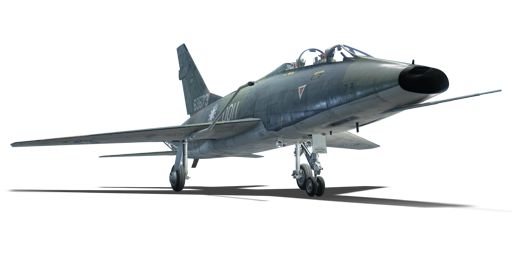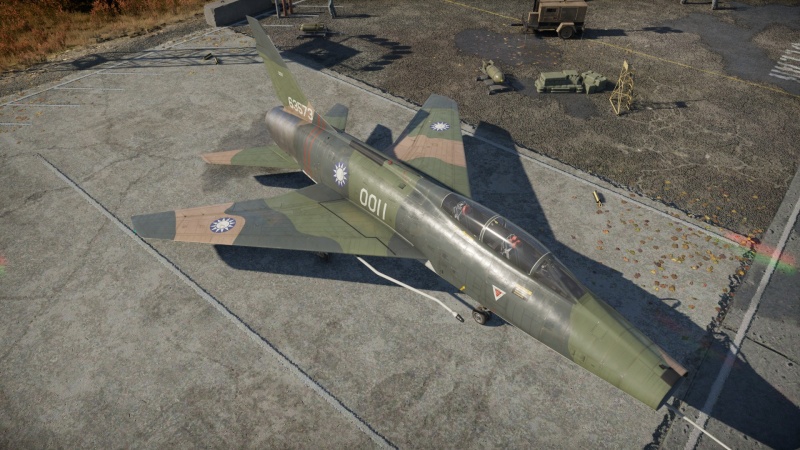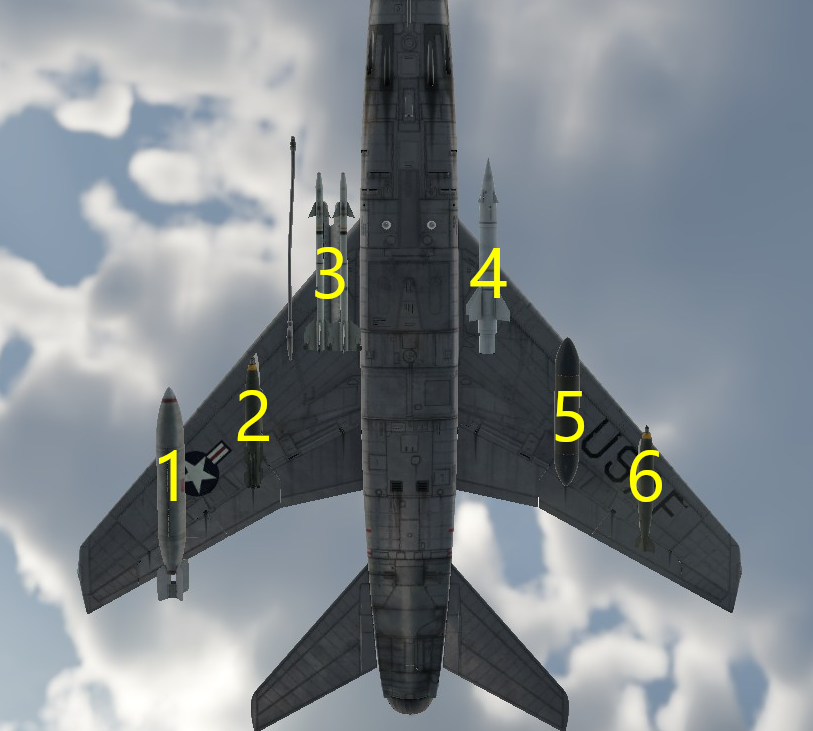Difference between revisions of "F-100F (China)"
(Edits) |
bss_Ukraine (talk | contribs) (Added history of F-100F and links for this part of article) (Tag: Visual edit) |
||
| Line 236: | Line 236: | ||
== History == | == History == | ||
<!-- ''Describe the history of the creation and combat usage of the aircraft in more detail than in the introduction. If the historical reference turns out to be too long, take it to a separate article, taking a link to the article about the vehicle and adding a block "/History" (example: <nowiki>https://wiki.warthunder.com/(Vehicle-name)/History</nowiki>) and add a link to it here using the <code>main</code> template. Be sure to reference text and sources by using <code><nowiki><ref></ref></nowiki></code>, as well as adding them at the end of the article with <code><nowiki><references /></nowiki></code>. This section may also include the vehicle's dev blog entry (if applicable) and the in-game encyclopedia description (under <code><nowiki>=== In-game description ===</nowiki></code>, also if applicable).'' --> | <!-- ''Describe the history of the creation and combat usage of the aircraft in more detail than in the introduction. If the historical reference turns out to be too long, take it to a separate article, taking a link to the article about the vehicle and adding a block "/History" (example: <nowiki>https://wiki.warthunder.com/(Vehicle-name)/History</nowiki>) and add a link to it here using the <code>main</code> template. Be sure to reference text and sources by using <code><nowiki><ref></ref></nowiki></code>, as well as adding them at the end of the article with <code><nowiki><references /></nowiki></code>. This section may also include the vehicle's dev blog entry (if applicable) and the in-game encyclopedia description (under <code><nowiki>=== In-game description ===</nowiki></code>, also if applicable).'' --> | ||
| − | '' | + | The '''[https://www.nationalmuseum.af.mil/Visit/Museum-Exhibits/Fact-Sheets/Display/Article/196002/north-american-f-100f-super-sabre/ F-100F Super Sabre]''' was an American supersonic jet fighter-bomber developed by North American Aviation in the early 1950s. The F-100F was a two-seat trainer variant of the [https://wiki.warthunder.com/F-100D F-100D], intended primarily for advanced pilot training. However, it also found a secondary role in various air forces around the world, including the Republic of China Air Force (ROCAF), where it played a crucial role during the Cold War era. |
| + | |||
| + | The F-100F entered service with the United States Air Force (USAF) in 1958 and soon after, several of these aircraft were transferred to allied nations, including Taiwan, under the Military Assistance Program (MAP). Taiwan's acquisition of the F-100F was part of a broader effort to modernize its air force during the tense Cold War period. | ||
| + | |||
| + | The F-100F Super Sabre played a critical role in the modernization of the Republic of China Air Force during a time of intense geopolitical tension in East Asia. While primarily a trainer, the aircraft's combat capabilities allowed it to perform vital reconnaissance and defensive missions, contributing to Taiwan's national security during the Cold War. | ||
| + | |||
| + | The F-100F's service in Taiwan is a testament to the adaptability and versatility of the Super Sabre design. Though it was eventually retired, the experience gained by ROCAF pilots on the F-100F provided a foundation for the development of Taiwan's modern air force. | ||
== Media == | == Media == | ||
| Line 260: | Line 266: | ||
* [[wt:en/news/8484-development-tokushu-heiki-f-100f-super-sabre-en|[Devblog] Tokushu Heiki: F-100F Super Sabre]] | * [[wt:en/news/8484-development-tokushu-heiki-f-100f-super-sabre-en|[Devblog] Tokushu Heiki: F-100F Super Sabre]] | ||
| + | * [https://www.nationalmuseum.af.mil/Visit/Museum-Exhibits/Fact-Sheets/Display/Article/196002/north-american-f-100f-super-sabre/ North American F-100F Super Sabre] | ||
| + | * [[wikipedia:Republic_of_China_Air_Force|Republic of China Air Force]] | ||
{{AirManufacturer NAA}} | {{AirManufacturer NAA}} | ||
{{China jet aircraft}} | {{China jet aircraft}} | ||
Revision as of 13:39, 10 August 2024
| This page is about the jet fighter F-100F (China). For other versions, see F-100 (Family). |
Contents
Description
The ␗F-100F Super Sabre, colloquially known as the 超級軍刀機 (Super Sabre jet), was the twin-seater variant of the F-100 and the first supersonic jet in ROCAF service, serving until 1984. These jets were mostly identical to USAF variants minus INS for SEAD capabilities (the F-100F was also the first Wild Weasel jet). During the 2nd Taiwan Strait Crisis in August 1958, the USAF transferred six F-100Fs to the ROCAF under the Military Aid Program (MAP), with four more jets by September. Due to the arrival of the F-104 to the ROCAF in the 1960s and the lack of major aerial combat between the ROCAF and PLAAF, the F-100Fs usually served as trainers, CAP, and ground attackers. However, due to a transporter crash in 1979 that cost almost all the F-100 engineers in ROCAF and consecutive crashes involving the fleet of F-100s, they were soon phased out with the last squadron them until 1984, replaced by later series F-104Gs or AIDC-assembled F-5Es.
Introduced during Update "Sons of Attila" as a reward for the 2023 Tokushu Heiki event, the F-100F extends its combat capability over the preceding F-100A thanks to its better payload for ground attack. While it can cause extensive damage to ground targets, be sure to take extra caution against enemy jets, as most supersonic jets of its tier will not have a hard time taking down the F-100F. Even though two cannons were removed from the nose, the ballistic performance of the M39 and up to four AIM-9Es ensures that it still has the chance to turn the tides with its somewhat good AoA that is traded with its speed.
General info
Flight performance
Aside from the rear-seat, the F-100F looks mostly identical to any other F-100 series in the game, especially with its signature "catfish" intake. However, it handles quite differently from the tech-tree F-100A, especially due to its weight - the F variant adds a rear seat for the weapons officer, therefore the weight of the extra pilot and extended cockpit should be considered as well.
The F-100F has a very hard time following the path of its arch enemy, the MiG-19, in a dogfight. However, due to its larger wings, the F-100F is able to pull greater AoA at low-medium speeds, though at the cost of a significant amount of energy, which may allow it to come out on top if used to its advantage in key situations.
| Characteristics | Max speed (km/h at 10,671 m) |
Max altitude (metres) |
Turn time (seconds) |
Rate of climb (metres/second) |
Take-off run (metres) | |||
|---|---|---|---|---|---|---|---|---|
| AB | RB | AB | RB | AB | RB | |||
| Stock | 1,445 | 1,437 | 15240 | 29.6 | 30.7 | 117.0 | 108.7 | 900 |
| Upgraded | ___ | ___ | __._ | __._ | __._ | __._ | ||
Details
| Features | |||||
|---|---|---|---|---|---|
| Combat flaps | Take-off flaps | Landing flaps | Air brakes | Arrestor gear | Drogue chute |
| ✓ | ✓ | ✓ | ✓ | X | ✓ |
| Limits | ||||||
|---|---|---|---|---|---|---|
| Wings (km/h) | Gear (km/h) | Flaps (km/h) | Max Static G | |||
| Combat | Take-off | Landing | + | - | ||
| 1361 | 447 | 620 | 590 | 435 | ~11 | ~4 |
| Optimal velocities (km/h) | |||
|---|---|---|---|
| Ailerons | Rudder | Elevators | Radiator |
| < 640 | < 540 | < 610 | - |
Engine performance
| Engine | Aircraft mass | |||||||
|---|---|---|---|---|---|---|---|---|
| Engine name | Number | Basic mass | Wing loading (full fuel) | |||||
| Pratt & Whitney J57P21 | 1 | 10,847 kg | 386 kg/m2 | |||||
| Engine characteristics | Mass with fuel (no weapons load) | Max Gross Weight | ||||||
| Weight (each) | Type | 14m fuel | 20m fuel | 30m fuel | 46m fuel | |||
| 2,361 kg | Afterburning axial-flow turbojet | 11,897 kg | 12,345 kg | 13,094 kg | 14,348 kg | __,___ kg | ||
| Maximum engine thrust @ 0 m (RB/SB) | Thrust to weight ratio @ 0 m (WEP) | |||||||
| Condition | 100% | WEP | 14m fuel | 20m fuel | 30m fuel | 46m fuel | MGW | |
| Stationary | 4,424 kgf | 5,823 kgf | 0.49 | 0.47 | 0.44 | 0.41 | _.__ | |
| Optimal | 4,424 kgf (0 km/h) |
8,364 kgf (1,200 km/h) |
0.70 | 0.68 | 0.64 | 0.58 | _.__ | |
Survivability and armour
- 64 mm bulletproof glass: windscreen
- 12.7 mm steel: behind pilots
Jets at the dawn of the supersonic era still have some extent of protection for the pilot despite the abundance of heavy autocannons on Warsaw-Pact aircraft. The protection of F-100F is mostly identical to other the F-100 series, other than having additional protection for the Weapon System Officer (aka rear-pilot). While autocannons more than 20 mm calibre can knock out the pilots with ease, earlier jets with only machine guns will need more precise hits on pilots or sustained hits on the airframe to send it to back to the hangar.
Modifications and economy
Armaments
| Ballistic Computer | ||||
|---|---|---|---|---|
| CCIP (Guns) | CCIP (Rockets) | CCIP (Bombs) | CCRP (Bombs) | EEGS |
| |
|
|
|
|
Offensive armament
The F-100F (China) is armed with:
- 2 x 20 mm M39A1 cannons, chin-mounted (175 rpg = 350 total)
Suspended armament
The F-100F (China) can be outfitted with the following ordnance:
| 1 | 2 | 3 | 4 | 5 | 6 | ||
|---|---|---|---|---|---|---|---|
| 500 lb LDGP Mk 82 bombs | 1 | 1 | 1, 3 | 1, 3 | 1 | 1 | |
| 500 lb Mk 82 Snakeye bombs | 1 | 1 | 1, 3 | 1, 3 | 1 | 1 | |
| 750 lb M117 cone 45 bombs | 1 | 1 | 1, 2 | 1, 2 | 1 | 1 | |
| 1,000 lb LDGP Mk 83 bombs | 1 | 1 | 1 | 1 | |||
| BLU-27/B incendiary bombs | 1 | 1 | 2 | 2 | 1 | 1 | |
| FFAR Mighty Mouse rockets | 19 | 19 | 19 | 19 | |||
| AGM-12B Bullpup missiles | 1 | 1 | |||||
| AIM-9B Sidewinder missiles | 1, 2 | 1, 2 | |||||
| AIM-9E Sidewinder missiles | 2 | 2 | |||||
| Chaff | 153 | 153 |
| Default weapon presets | |
|---|---|
| |
Usage in battles
Describe the tactics of playing in the aircraft, the features of using aircraft in a team and advice on tactics. Refrain from creating a "guide" - do not impose a single point of view, but instead, give the reader food for thought. Examine the most dangerous enemies and give recommendations on fighting them. If necessary, note the specifics of the game in different modes (AB, RB, SB).
Radars
Pros and cons
Pros:
- Weapon System Officer (WSO; or rear-pilot) has access to aircraft control for last-ditch retaliation
- Higher and more extensive payload for multirole operations than F-100 series including (wing-mounted) chaffs
- Good ballistics for the M39 autocannon
- RWR for better situational awareness at its BR
Cons:
- Heavier airframe than earlier F-100 series thus less manoeuvrable
- Lacks a pair of autocannons compared to the previous F-100 series
- Control surfaces lock up at supersonic speeds
- Any manoeuvres will severely bleed energy
- Lacks ballistic computer for precise ground attack
History
The F-100F Super Sabre was an American supersonic jet fighter-bomber developed by North American Aviation in the early 1950s. The F-100F was a two-seat trainer variant of the F-100D, intended primarily for advanced pilot training. However, it also found a secondary role in various air forces around the world, including the Republic of China Air Force (ROCAF), where it played a crucial role during the Cold War era.
The F-100F entered service with the United States Air Force (USAF) in 1958 and soon after, several of these aircraft were transferred to allied nations, including Taiwan, under the Military Assistance Program (MAP). Taiwan's acquisition of the F-100F was part of a broader effort to modernize its air force during the tense Cold War period.
The F-100F Super Sabre played a critical role in the modernization of the Republic of China Air Force during a time of intense geopolitical tension in East Asia. While primarily a trainer, the aircraft's combat capabilities allowed it to perform vital reconnaissance and defensive missions, contributing to Taiwan's national security during the Cold War.
The F-100F's service in Taiwan is a testament to the adaptability and versatility of the Super Sabre design. Though it was eventually retired, the experience gained by ROCAF pilots on the F-100F provided a foundation for the development of Taiwan's modern air force.
Media
- Skins
See also
- Related development
External links
- [Devblog] Tokushu Heiki: F-100F Super Sabre
- North American F-100F Super Sabre
- Republic of China Air Force
| North American Aviation | |
|---|---|
| Fighters | |
| P-51A | P-51 · P-51A |
| P-51C | P-51C-10 |
| P-51D | P-51D-5 · P-51D-10 · P-51D-20-NA · P-51D-30 |
| P-51H | P-51H-5-NA |
| Twin-engine fighters | F-82E |
| Jet fighters | F-86A-5 · F-86F-2 · F-86F-25 · F-86F-35 · F-100D |
| Strike aircraft | A-36 · PBJ-1H · PBJ-1J |
| FJ-4B · FJ-4B VMF-232 | |
| Bombers | B-25J-1 · B-25J-20 |
| Export/Licence | ▂B-25J-30 · ␗B-25J-30 |
| ▄Mustang Mk IA · F-6C-10-NA · ␗P-51C-11-NT · ␗P-51D-20 · J26 David · J26 · P-51D-20-NA · ␗P-51K | |
| F-86F-30 ▅ · ␗F-86F-30 · F-86F-40 ▅ · F-86F-40 JASDF▅ · ␗F-86F-40 | |
| ◄F-86K · ▄F-86K (Italy) · ▄F-86K (France) | |
| ␗F-100A · ▄F-100D · ␗F-100F | |
| Captured | ▅P-51C-11-NT |
| Canadair Limited license-built the F-86 as the CL-13 for use in Canada and export to Europe. | |
| Fiat license-built the F-86K for the Italian Air Force though another 120 NAA built F-86Ks were also sold to the Italians. | |
| See Also | Mitsubishi Heavy Industries · Canadair Limited · Fiat Aviation |
| China jet aircraft | |
|---|---|
| Fighters | J-2 · J-4 · J-6A · J-7II · J-7D · J-7E · J-8B · J-8F · J-10A · J-11 · J-11A |
| Strike aircraft | Q-5 early · Q-5A · Q-5L · JH-7A |
| Bombers | H-5 |
| France | ␗Mirage 2000-5Ei |
| USA | ␗F-84G-21-RE · ␗F-84G-31-RE · ␗F-86F-30 · ␗F-86F-40 · ␗F-100A · ␗F-100F · ␗F-104A · ␗F-104G · ␗F-5A · ␗F-5E · ␗F-16A MLU |
| USSR | ␗MiG-9 · ␗MiG-9 (l) |
| North Korea | Shenyang F-5 |
| Pakistan | A-5C · JF-17 |






